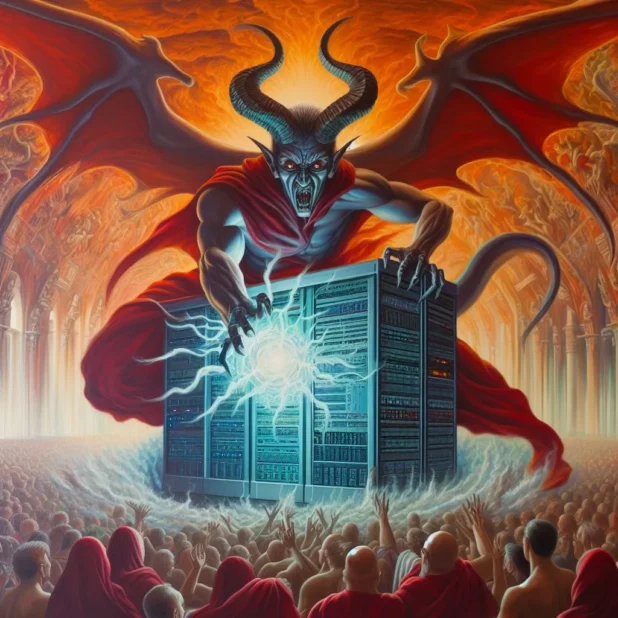I’ve told you since forever that these people are using AI to make all their decisions.
It was just obvious.
Now they’re going to start admitting it, and acting like it’s very clever of them.
Israel’s military has made no secret of the intensity of its bombardment of the Gaza Strip. In the early days of the offensive, the head of its air force spoke of relentless, “around the clock” airstrikes. His forces, he said, were only striking military targets, but he added: “We are not being surgical.”
There has, however, been relatively little attention paid to the methods used by the Israel Defense Forces (IDF) to select targets in Gaza, and to the role artificial intelligence has played in their bombing campaign.
As Israel resumes its offensive after a seven-day ceasefire, there are mounting concerns about the IDF’s targeting approach in a war against Hamas that, according to the health ministry in Hamas-run Gaza, has so far killed more than 15,000 people in the territory.
The IDF has long burnished its reputation for technical prowess and has previously made bold but unverifiable claims about harnessing new technology. After the 11-day war in Gaza in May 2021, officials said Israel had fought its “first AI war” using machine learning and advanced computing.
The latest Israel-Hamas war has provided an unprecedented opportunity for the IDF to use such tools in a much wider theatre of operations and, in particular, to deploy an AI target-creation platform called “the Gospel”, which has significantly accelerated a lethal production line of targets that officials have compared to a “factory”.
The Guardian can reveal new details about the Gospel and its central role in Israel’s war in Gaza, using interviews with intelligence sources and little-noticed statements made by the IDF and retired officials.
This article also draws on testimonies published by the Israeli-Palestinian publication +972 Magazine and the Hebrew-language outlet Local Call, which have interviewed several current and former sources in Israel’s intelligence community who have knowledge of the Gospel platform.
…
In early November, the IDF said “more than 12,000” targets in Gaza had been identified by its target administration division.
Describing the unit’s targeting process, an official said: “We work without compromise in defining who and what the enemy is. The operatives of Hamas are not immune – no matter where they hide.”
The activities of the division, formed in 2019 in the IDF’s intelligence directorate, are classified.
However a short statement on the IDF website claimed it was using an AI-based system called Habsora (the Gospel, in English) in the war against Hamas to “produce targets at a fast pace”.
The IDF said that “through the rapid and automatic extraction of intelligence”, the Gospel produced targeting recommendations for its researchers “with the goal of a complete match between the recommendation of the machine and the identification carried out by a person”.
Multiple sources familiar with the IDF’s targeting processes confirmed the existence of the Gospel to +972/Local Call, saying it had been used to produce automated recommendations for attacking targets, such as the private homes of individuals suspected of being Hamas or Islamic Jihad operatives.
In recent years, the target division has helped the IDF build a database of what sources said was between 30,000 and 40,000 suspected militants. Systems such as the Gospel, they said, had played a critical role in building lists of individuals authorised to be assassinated.
Aviv Kochavi, who served as the head of the IDF until January, has said the target division is “powered by AI capabilities” and includes hundreds of officers and soldiers.
In an interview published before the war, he said it was “a machine that produces vast amounts of data more effectively than any human, and translates it into targets for attack”.
According to Kochavi, “once this machine was activated” in Israel’s 11-day war with Hamas in May 2021 it generated 100 targets a day. “To put that into perspective, in the past we would produce 50 targets in Gaza per year. Now, this machine produces 100 targets a single day, with 50% of them being attacked.”
Precisely what forms of data are ingested into the Gospel is not known. But experts said AI-based decision support systems for targeting would typically analyse large sets of information from a range of sources, such as drone footage, intercepted communications, surveillance data and information drawn from monitoring the movements and behaviour patterns of individuals and large groups.
The target division was created to address a chronic problem for the IDF: in earlier operations in Gaza, the air force repeatedly ran out of targets to strike. Since senior Hamas officials disappeared into tunnels at the start of any new offensive, sources said, systems such as the Gospel allowed the IDF to locate and attack a much larger pool of more junior operatives.
One official, who worked on targeting decisions in previous Gaza operations, said the IDF had not previously targeted the homes of junior Hamas members for bombings. They said they believed that had changed for the present conflict, with the houses of suspected Hamas operatives now targeted regardless of rank.
“That is a lot of houses,” the official told +972/Local Call. “Hamas members who don’t really mean anything live in homes across Gaza. So they mark the home and bomb the house and kill everyone there.”
I don’t think Elvis did too bad with the AI art this time.
I’ve seen worse.
In fact, I’ve done worse myself.
 Daily Stormer The Most Censored Publication in History
Daily Stormer The Most Censored Publication in History






